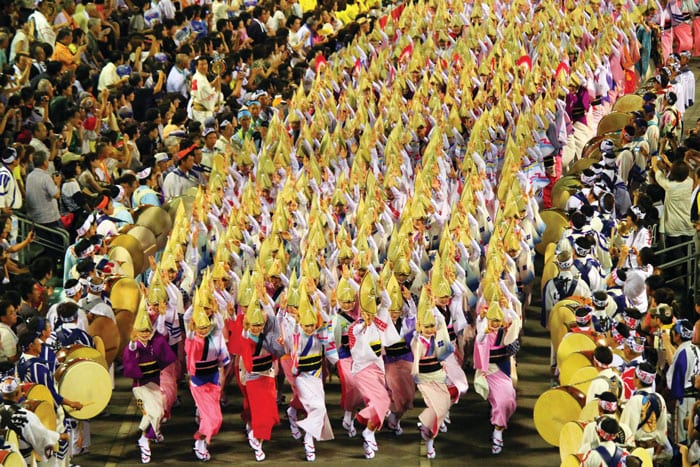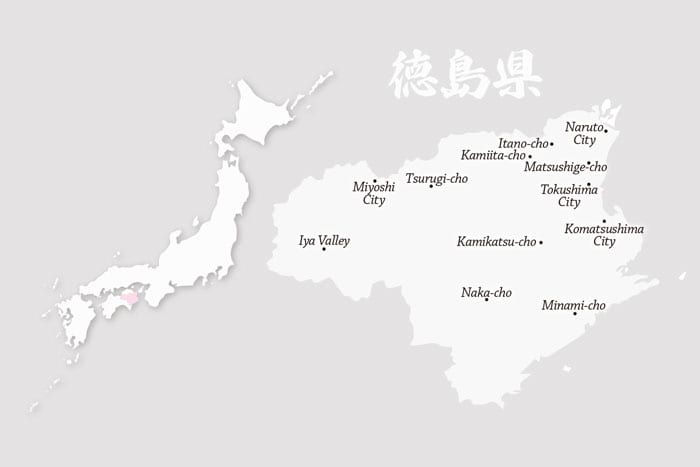Flying into Tokushima affords a bird’s eye view over the distinctive geography of this easternmost prefecture of Shikoku island, where idyllic pastoral scenes of rivers, bridges and fields carpeted with flowers never seem far from the easily navigable capital, satellite towns and picture-postcard villages. Indeed, almost a tenth of Tokushima is taken up by national parks, while a significant slice of the immaculate countryside is given over to agriculture, and the growth of produce that makes up some of the area’s most emblematic dishes.

Tokushima’s folk dance, Awa-odori, is one of the best-known in all of Japan and is regularly performed in cities across the country
But perhaps its most notable feature is the spectacular terrain of the Sanuki mountain range that rings the prefecture’s northern border, and provides a stunning backdrop to journeys around Tokushima. The Naruto Strait is another beautiful viewpoint that sits in between the Seto Inland Sea and the Pacific, and provides both tourism opportunities—with its stunning bridge overlooking renowned whirlpools—and a rich source of seafood.
The prefecture is amply proportioned, rewarding many days of exploration, yet it was once larger. Previously known as Awa-no-kuni till the end of the Edo Era, and then after the Meiji Restoration as Myodo-gun—visitors will note the word “awa” on public signs and product names around the island—the prefecture eventually shed its adjoining territories of Awa region and Awaji island, before finally being named Tokushima in 1880. Nowadays its most famous cultural institution and export is Awa-odori, an exuberant folk dance that lends its name to Japan’s biggest dance festival every August.
While industrialisation and infrastructure projects stepped up in the postwar period, the year-round warm, sometimes humid subtropical climate here—the hottest month is August, the wettest September—led to farming becoming its chief industry in this environment that’s ideally suited to fertile agriculture. The plains north of the Yoshino river became known for their abundant produce, and diners in cities as far-flung as Kobe, Osaka and Kyoto have been well acquainted over the years with key Tokushima foodstuffs such as sweet potatoes, sudachi, hamo eel, lobster, strawberries, rice and yuzu. Tokushima is even known to produce colourful, edible flowers, including almost all of the nation’s indigo dye.
Over the following pages you can find out how all these regional specialities contribute to the character of Tokushima’s cuisine, craft and culture. Get ready for a beautiful and delicious journey!

>>Read more about Tokushima Products
>>Read more about Tokushima Foods
>>Read more about Tokushima Sights
>>Read more about Tokushima Souvenir
(TEXT Jonathan Evans Photography kojiro sugimoto)
Tradition with a twist in Tokushima
Inerview
Head Chef, Yamamomo restaurant, Awa Kanko Hotel
Chef Motoki has worked for 29 years at this time-honoured hotel, and still seeks to innovate with dishes that he’s devised to cater to Islamic guests. He tells us how this demand made him reconsider the preparation of his colourful kaiseki menu.
What made you decide to offer halal food?
We started having customers from Malaysia, and then other Muslim countries, so my challenge was using halal ingredients and creating Japanese kaiseki with good style and taste. We use miso, soy sauce and vinegar that are halal certified; our beef is also handled appropriately.
What are the special ingredients from Tokushima that you’re using for this menu?
We are using Naruto kintoki sweet potato, yuzu, Handa somen, Naruto tai (red sea bream), pear and persimmon. We change the kaiseki menu according to season, and use bamboo or lotus leaves to decorate our dishes.
Your dishes are very brightly coloured. Is the presentation as important as the taste?
With any Japanese food we say you don’t just taste with your tongue, but eat with your eyes. In the autumn and spring it gets very colourful, so the food reflects nature in each season.
Which drinks would you recommend to complement this kaiseki menu?
I’d recommend sudachi or yuzu juice with soda – it should be very refreshing. Also, of course, Japanese tea! From this region, there is Awa Bancha, a brown tea where green leaf is fermented by lactic acid.
Which attractions and activities would you recommend for tourists in Tokushima?
Go and see the whirlpool at Naruto, the ancient bridge made of vines, and go whitewater rafting at Iya Valley!
Vice Chairman, Tokushima Awa-odori Association
The Awa-odori folk dance dates to the Middle Ages. A dance festival every August is the largest event in Tokushima, and draws participants and spectators from all over Japan. Now 76, the man in charge of keeping this artform alive talks about his passion.
Can you tell us about the history of this dance?
Awa-odori goes back more than 420 years. It’s a typical Bon (traditional Buddhist) dance performed to receive ancestors’ spirits.
What’s special about the Awa-odori?
The dance is very “free”. It’s only done on two beats, so it’s easier; and there are six instruments. In Japan, there are usually only three instruments for this dance. Out of 980 teams, only 33 are allowed to perform the dance in this space (Awaodori Kaikan).
Which age groups are represented in the teams?
We visit schools to recruit young people. They need 10 years’ experience before performing in public. Our youngest dancers can be as little as five, and there’s no upper limit – you can be as old as you wish.
How do you maintain this dance tradition?
One important factor is taking the dance out on the road so that people know about our culture internationally. This summer I went to France, the Netherlands and Sweden, and did a demonstration. Whenever we went, everyone started dancing – sometimes 10,000 or 20,000 people!
What kind of impact has Awaodori Kaikan had?
Before, you could only see this dance at hotels organised by travel agencies. Here, it’s like coming to a movie theatre! I’ve appeared in the media, so people see me and say, “I want to dance like him!”
Tell us more about the annual festival here.
It lasts for four days, and 190 teams take part. This might be the largest festival in Japan: 1.3 million people visit (12–15 August). Costumes are bright and loose; lanterns correspond with the colours. It’s just spectacular!
>>Read more about Tokushima Products
>>Read more about Tokushima Foods
>>Read more about Tokushima Sights
>>Read more about Tokushima Souvenir
Tokushima In A Year
Fertile soil rich with minerals, clean rivers, widespread agricultural land and a subtropical climate form the perfect conditions for Tokushima’s finest produce. Encompassing all kinds of foods, from animals to fruits and vegetables, some of its best-known products are seasonal. Here’s an overview of the best the prefecture has to offer in the course of a year.
春 – Spring (March to May)
▶ Naruto tai (Red Sea Bream): above picture
▶ Naruto Wakame (Wakame Seaweed)
▶ Dried young sardines
▶ Strawberry
▶ Canola Flower: above picture
▶ Cauliflower
夏 – Summer(June to August)
▶ Abalone: above picture
▶ Sudachi (Citron): above picture
▶ Pear
▶ Grape
秋 – Autumn(September to November)
▶ Bigfin Reef Squid: above picture
▶ Boze (Butterfish)
▶ Naruto kintoki (Sweet Potato): above picture
▶ Rice
▶ Komatsuna (Japanese Mustard Spinach)
冬 – Winter(December to February)
▶ Ise Ebi (Spiny Lobster): above picture
▶ Buri (Yellowtail)
▶ Green laver
▶ Yuzu: above picture
▶ Tomato
▶ Lotus root
▶ Daikon radish
>>Read more about Tokushima Products
>>Read more about Tokushima Foods